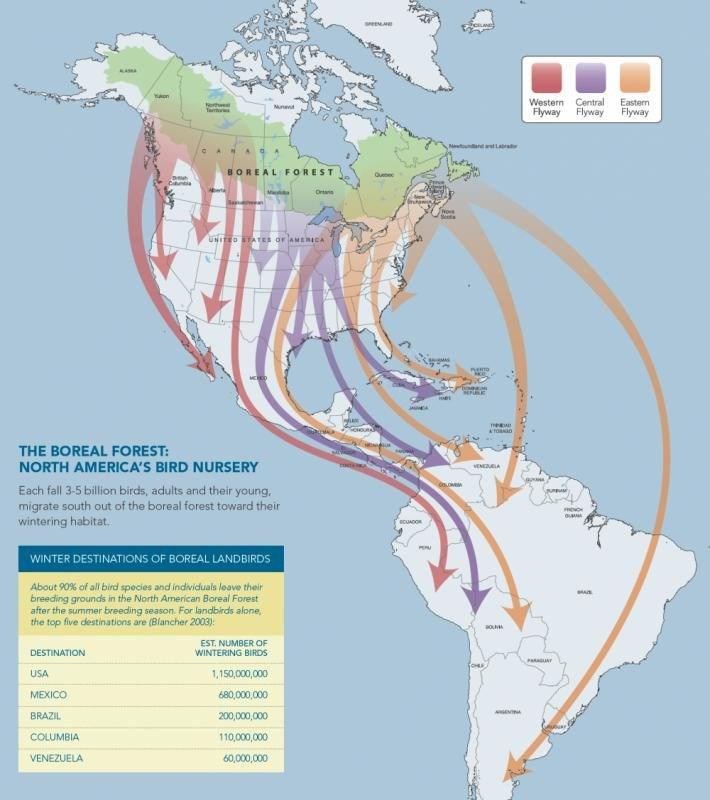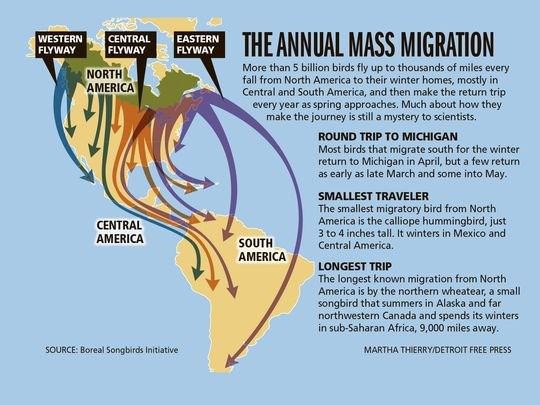By Terry Sovil from the June 2018 Edition
Are there any birds that migrate back and forth from Canada to Mexico and maybe spend some time in the USA on the way? Turns out that over 350 different species have a second home in Mexico! There are flight paths all the way from the great Boreal Forest in Canada to South America!
Migration?
Bird migration is an annual, seasonal event. It is driven by the need for food. As winter sets in, food and insects becomes scarcer. Getting warm is an issue but many birds, including some hummingbirds, can tolerate the winter if there is enough food.
So, with no passports needed, the borders don’t stop the migrating birds. Over 350 species of birds travel from the US and Canada to Mexico. There are four general types of migratory species: winter residents, summer residents, just passing through and migrants with a resident population.
The winter residents, about 145 species, reproduce in their home area and they winter in Mexico. Some go down as far as Central America. These include the golden cheeked warblers of Texas.
Summer residents, 30 species, reproduce in Mexico and spend the winter more south. The Lucifer hummingbird is one.
Passers-by, about 35 species, breed north of Mexico and then winter in Central or South America. One, the pectoral sandpiper, breeds in Alaska and Northern Canada then spends the winter in South America.
Migratory populations with resident populations are about 140 species, such as diver birds, which breed in Canada and the United States and winter in Mexico, although there are popula-tions that stay year round in Durango and Zacatecas.
Migration Hazards

The migration itself is difficult, with high rates of predators kill-ing the migrating birds. One of the big concerns is loss of habitat, both in their own country and along the way. Pollution such as oils and pesticides, uncontrolled hunting and climate change are problematic. I read a lot about the huge decrease in the numbers of birds and the need for cooperation between countries to help control impacts on bird migration.
One of the problems is a lack of protection, in the forests and everywhere, which makes them exploited. Coastal roads, habitat destruction, over exploitation of wildlife and loss of vegetation are a loss of food supply. Human settlement, logging and agricultural pressures also change the forests.
Mexico plays a key role as it is a major migratory route where all kinds of birds stay and migrate through but depend on Mexican resources to continue their travel.
Some scientists warn that good habitat in Mexico is disappearing, forcing birds to go to less optimal spots where they do not have the same resources. They may not survive the migration and the winter. Another result is they do not have the strength to return to their place of origin and die. One example is the Golden Cheeked Warblers that reproduce in certain areas of Texas, migrate to San Cristobal de las Casas for the winter and their population has begun to reduce considerably.
Range Charts and Bird Species
I included 2 charts that show migration paths and areas. It is pretty humbling to look at the distances and number of birds that migrate!
One of most talked about birds is the Colima warbler that migrates from Big Bend National Park in Texas to the south where they winter in Chiapas and Guatemala. This park is heavily promoted and advertised with many bird-watching tours heading there during the season.
Can you see some of these birds here, in the state of Colima? Yes! The Jalisco dry forests get many of them. Located along the Pacific coast, the states of Nayarit, Jalisco and Colima are an area of small mountains with elevations from 2000 meters or 6500 feet, and up to 4000m (13000 feet), near the Colima Volcano. It is tropical sub humid, with rain during the wet season (May to November). There is a distinct dry season too (December to May) with many trees losing their leaves. Near the Colima Volcano, there is lava and volcano created formations. These forests are among the richest in the world! There are about 300 bird species here. The forests are a critical habitat for birds from Canada and the US and 45% of the species are migrants.

These migratory species are trinational, splitting time in Canada, US and Mexico over the calendar year. These three countries need to step up more to preserve the natural heritage of all 1,154 bird species in North America. There was a report put together by Citizen Science (The Cornell Lab of Ornithology) that measured bird migration and documented long-term changes in bird numbers. Tens of thousands of Canadians, Americans and Mexicans contributed data analyzed by scientists from all 3 countries.
Here are some examples of birds that migrate:
• Scarlet tanager: Pennsylvania to Brazil
• Western tanager: Oregon to Costa Rica
• Black-throated blue warbler: Michigan to Jamaica
• Wood thrush: Ontario to Mexico
• American golden-plover: Northern Alaska to southern Argentina
• Blackpoll warbler: Eastern Canada to northern South America
• Great Blue Heron: Southern Canada as far as the Caribbean
• Golden Eagle: Canada, primarily the west, to Mexico, Gulf Coast and Florida
• American White Pelican: Northwest Territories to USA and Mexico
Only 22% of Canadian bird species spend the whole year in Canada. Most migrate to the USA (33%), to Mexico, Central America and Caribbean (23%), South America (15%), or Europe Asia, at sea (7%).
What can we do?
Like so many things with nature, we need to study and understand and then try to preserve. Ask corporations through their business operations, and citizens like you and I through our consumer choices, to take a larger role in mitigating deforesta-tion, development, pollution, and climate change.
Download the full edition or view it online
—
Terry is a founding partner and scuba instructor for Aquatic Sports and Adventures (Deportes y Aventuras Acuáticas) in Manzanillo. A PADI (Professional Association of Dive Instructors) Master Instructor in his 36th year as a PADI Professional. He also holds 15 Specialty Instructor Course ratings. Terry held a US Coast Guard 50-Ton Masters (Captain’s) License. In his past corporate life, he worked in computers from 1973 to 2005 from a computer operator to a project manager for companies including GE Capital Fleet Services and Target. From 2005 to 2008, he developed and oversaw delivery of training to Target’s Loss Prevention (Asset Protection) employees on the West Coast, USA. He led a network of 80+ instructors, evaluated training, performed needs assessments and gathered feedback on the delivery of training, conducted training in Crisis Leadership and Non-Violent Crisis Intervention to Target executives. Independently, he has taught hundreds of hours of skills-based training in American Red Cross CPR, First Aid, SCUBA and sailing and managed a staff of Project Managers at LogicBay in the production of multi-media training and web sites in a fast-paced environment of artists, instructional designers, writers and developers, creating a variety of interactive training and support products for Fortune 1000 companies.



